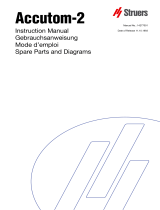La page est en cours de chargement...

Tenupol-3
Instruction Manual
Gebrauchsanweisung
Mode d’emploi
Spare Parts and Diagrams
Manual No.: 14087001
Date of Release 21.11.1997

Tenupol-3
Instruction Manual
Table of Contents Page
Instruction Manual ...................................................... 1
Gebrauchsanweisung .............................................. 28
Mode d’emploi .......................................................... 59
Spare Parts and Diagrams ....................................... 89

Tenupol-3
Instruction Manual
1
Instruction Manual
Always state
Serial No and Voltage/frequency if you have technical questions or when ordering spare parts.
You will find the Serial No. and Voltage on the type plate of the machine itself. We may also need the
Date
and
Article No of the manual. This information is found on the front cover.
The follo
wing restrictions should be observed, as violation of the restrictions may cause cancellation of
Struers legal obligations:
Instruction Manuals:
Struers Instruction Manual may only be used in connection with Struers equipment
covered by the Instruction Man
ual.
Service Manuals:
Struers Service Manual may only be used by a trained technician authorised by Struers.
The Service Manual may only be used in connection with Struers equipment covered by the Service Manual.
Struers assumes no responsibility for erro
rs in the manual text/illustrations. The information in this manual is
subject to change without notice. The manual may mention accessories or parts not included in the present
version of the equipment.
The contents of this manual are the property of Stru
ers. Reproduction of any part of this manual without the
written permission of Struers is not allowed.
All rights reserved. © Struers 1997.
Struers A/S
Valhøjs Allé 176
DK
-2610 Rødovre/Copenhagen
Denmark
Telephone +45 36 70 35 00
Fax +45 38 27 27 01

Tenupol-3
Instruction Manual
2
Tenupol-3
Safety Precaution Sheet
To be read carefully
before use
1. The operator must be fully instructed in the use of the instrument,
according to this manual.
2. The operator must be fully instructed in the use of the electrolytes used
with Tenupol-3.
3. Observe the current safety precautions regarding the handling, mixing,
filling and disposal of the electrolyte.
Material Safety Data Sheets on request.
4. Check the model plate and the mains voltage selector prior to the
power sully connection.
5. Check that the polishing unit is standing firmly on the support in order
not to tip over.
6. Do not leave the instrument unattended when filled with electrolyte.
7. The polishing process develops heat. Keep the electrolyte temperature
below the flashpoint of the actual electrolyte.
The equipment is designed for use with consumables supplied by Struers. If subjected to misuse, improper
installation, alteration, neglect, accident or improper repair, Struers will accept no responsibility for
damage(s) to the user or the equipment.
Dismantling of any part of the equipment, during service or repair, should always be performed by a qualified
technician (electromechanical, electronic, mechanical, pneumatic, etc.)

Tenupol-3
Instruction Manual
3
Table of Contents Page
1. Installation ................................................... 4
1.1. Packing List .......................................................................................... 4
1.2. Placing ................................................................................................. 4
1.3. Mounting and Connection of the Individual Units ................................ 5
1.4. Safety Precautions ............................................................................... 6
2. Operation ..................................................... 8
2.1. Introduction .......................................................................................... 8
2.2. Application ........................................................................................... 8
2.3. Function ............................................................................................... 8
2.4. Design .................................................................................................. 9
2.5. Operation of Control Unit ................................................................... 11
2.6. Operating the Polishing Unit .............................................................. 14
2.7. Operation Parameters ....................................................................... 16
2.8. Pre-treatment of the Specimen .......................................................... 18
2.9. Thinning, General .............................................................................. 19
2.10. Thinning Examples ............................................................................ 21
2.11. Electrolytes ........................................................................................ 21
2.12. Polishing Defects ............................................................................... 22
3. Accessories ................................................. 24
4. Maintenance ................................................ 25
4.1. Polishing Unit ..................................................................................... 25
4.2. Control Unit ........................................................................................ 25
5. Trouble-Shooting ........................................... 26
6. Technical Data ............................................. 27

Tenupol-3
Instruction Manual
4
1. Installation
1.1. Packing List
1 Control unit with cable for connection to main power supply
1 Polishing unit with polishing cell, cover for polishing cell, built-in
IR-transmitter/receiver, cooling coil and pump system as well as cable
and plug connector for control unit
1 Thermometer pocket
1 Thermometer +20/-50°C
1 Specimen holder for 03 mm specimens
1 Jet holders, inside diameter 1 mm, set with 2 pcs.
1 PVC-reservoir, insulated
1 PVC-reservoir, uninsulated
2 Ø8 mm tube for cooling coil, 2x1 m.
1 Jet holder with ascending tube
1 Return tube
1.2. Placing
Tenupol-3 is a stationary instrument for setting up in a laboratory. This
implies that the instrument must be placed on a plane and horizontal table.
The table must be resistant to chemicals. It is recommended to place the
polishing unit on a piece of impregnated paper or some other easily
replaceable protective foil.
Please note that the electrolytes to be used may result in demands for local
exhaust or installation in fume cupboard.
The control unit can either be placed next to the polishing unit or on a shelf
above the polishing unit. If placed on a table next to the polishing unit the
operating convenience can be increased by placing the control unit with the
built-in legs in an inclined position.

Tenupol-3
Instruction Manual
5
1.3. Mounting and Connection of the Individual Units
1.3.1. Polishing Unit
Place the base plate with pump, polishing cell etc. on top of the insulated
PVC-reservoir. The cooling coil and the pump must be immersed in the
reservoir. The pump motor and polishing cell must turn upwards (see fig.
11).
Put the thermometer pocket in the drilled hole (Fig. 2.5) between the
polishing cell and the pump motor. Put the thermometer into the pocket.
Mount the two jet holders and the specimen holder as described in sections
OPERATION.
Connect the polishing unit to the control unit. Connect the multi plug to the
socket on the right hand side of the control unit and fasten the coupling nut
of the plug. The fastening is done by hand, without use of spanners or other
tools.
Connect the cooling coil to a separate cooling unit, to the water pipe, or to
some other cooling arrangement which meets all technical and safety
regulations as well as any possible restrictions on consumption of water
resources.
Alternatively, the uninsulated vessel can be used as electrolyte reservoir.
Thus, a cooling effect can be obtained if this reservoir is placed in an ice
bath or another cooling bath.
1.3.2. Control Unit
On the left hand side of the instrument (Fig. 1.3) a mains voltage switch is
placed. Check that it is set according to the actual supply voltage.
The power cord supplied with the instrument is mounted in the
corresponding socket on the left hand side of the instrument (Fig. 1.4) and
then connected to the mains.
On the lower side of the instrument, approx. 5 cm from the front edge,
foldable legs (Fig. 1.5) are mounted at both sides. These legs can be used if
it is required that the front plate of the control unit should be more inclined.

Tenupol-3
Instruction Manual
6
1.4. Safety Precautions
1.4.1. Electrolytes
The electrolytes mentioned in section OPERATION can be used without
involving any risk for user or equipment if the safety precautions stated for
these electrolytes are followed.
Some of the electrolytes contain perchloric acid. See section OPERATION
for further information.
Tenupol-3 is designed for use with electrolytes recommended by Struers.
Other electrolytes, e.g. electrolytes containing strong bases or acids, may
harm the construction or endanger the safety of the user.
Note that many electrolytes contain alcohol or other inflammable solvents.
Make sure that all safety precautions are followed when using such
electrolytes.
It is essential that the user is fully trained in the use of Tenupol-3 as well as
the electrolytes involved.
When cleaning the instrument after use, make sure that no electrolyte is
allowed to dry and/or crystallize inside the instrument or on the polished
material.
1.4.2. Perchloric Acid
Electrolytes from Struers with the prefix A consist of approx. 11 stock
solution, to which from 15 to 90 ml perchloric acid (60%) is added. Thus, the
ready-made electrolyte will contain from 1 to 5% perchloric acid.
Electrolytes with such a low content of perchloric acid will not imply
considerable elements of risk. Before mixing, however, there will be 60%
perchloric acid present. Therefore, the following safety precautions for
perchloric acid must be observed:

Tenupol-3
Instruction Manual
7
All personnel involved in the mixing, use, storage, transportation, and
disposal of the electrolytes or its components, should be thoroughly
trained in the perchloric acid precautions.
Great importance must be attached to precautions against inhalation of
vapors of the solution or its components, against skin contact, mixing
and overheating, and concerning storage and disposal methods.
Add the perchloric acid to the solvent/water mixture slowly, stirring
continuously, in a water bath with temperature control.
The mixing must take place in a ventilated chemical fume hood
designed for perchloric acid use.
The operator(s) must use the listed protective clothing or devices: full
face shield or splash goggles, rubber gloves and lab coat or coveralls.
Avoid the use of any combustible or carbonaceous containers, reaction
vessels, spill pans, storage shelves, or materials of this type when
dealing with the acid.
Do not permit any acid to crystallize on bottle necks, caps, or anywhere
else.
Store in secure, ventilated area with metal, glass, or ceramic spill catch
pan.
Store away from other chemicals, combustible materials, and organics.
Do not permit solutions to dry out under any circumstances.
60% perchloric acid is classified as a Material that will not burn, but
caution should be taken against their coming in contact with organic
material which could cause an explosion.
Fire fighting should be done from a protected location. Extinguish with
water spray.
Do not produce anhydrous perchloric acid, either from its salts or from
aqueous solutions, e.g. by heating with high boiling acids or
dehydrating agents, such as sulfuric acid or phosphorous pentoxide. In
addition to spontaneous explosion, the anhydrous acid explodes
instantaneously in contact with oxidizable organic materials.
The use or storage of perchloric acid should be limited to quantities less
than 500 g per hood.
Follow local regulations when residues are to be disposed of.
Dilution and/or neutralization are the normally recommended methods
of disposal for the electrolyte.
A. Training operators
B. Mixing the solution
C. Storage of
the perchloric acid or solution
D. Fire and explosion hazards
E. Disposal

Tenupol-3
Instruction Manual
8
2. Operation
2.1. Introduction
Tenupol-3 comprises a base plate with a polishing cell, a built-in, infrared
detector system, a cooling coil and a pump system, all placed on top of a
PVC-reservoir for electrolyte. The electrical parts, pump etc. are connected
to a separate control and power supply unit through a single cable.
2.2. Application
Tenupol-3 is an automatic instrument for electrolytic thinning of specimens
for Transmission Electron Microscopy and other methods of examination
where the thickness of the specimens must correspond to or be smaller
than the grain size of the examined material.
2.3. Function
A specimen, normally max. 0.5 mm thick and with a diameter of 3 mm, is
placed between two immersed jets. A pump system sends a flow of
electrolyte through the jets against the specimen.
An electric circuit is established with a DC-power supply, with a cathode
placed in the electrolyte and with the specimen connected as anode.
When the electric circuit is closed, material will be removed electrolytically
from the specimen. This results in the forming of a small hole in the middle
of the specimen if the correct operating parameters have been used.
The edge of the hole will have a V-shaped cross section. The point of this
“V” will have the thickness required for the further structural examinations.
In Tenupol-3 the hole is detected by an infrared detector system, which
automatically cuts off the process. The liquid flow rate and the voltage can
be controlled from the control unit.

Tenupol-3
Instruction Manual
9
2.4. Design
The instrument comprises the following main parts:
2.4.1. Control Unit
A cable connects the polishing unit to the control unit. The cable contains all
connections to the polishing chamber, pump and IR transmitter/receiver.
The connection is done with a multi-plug on the right hand side of the
control unit. The sturdy steel cabinet contains power supply, electronics and
regulations for polishing voltage, photo sensitivity, flow rate and timer. Two
indicating instruments indicate voltage and current respectively during the
process.
It is possible to compensate for deviations of different electrolytes by setting
the instrument in “Adjust Mode”. In this mode Flow rate can be optimized to
the electrolyte in question.
2.4.2. Polishing Unit
The polishing unit comprises a PVC base plate (Fig. 2.1) on which the pump
system (Fig. 2.2), the polishing cell (Fig. 2.3) with jets and specimen holder,
a cooling coil (Fig. 2.4) as well as a thermometer (Fig. 2.5) are mounted.
Depending on the chosen cooling method the base plate is placed on an
insulated or non-insulated PVC-reservoir.
The electrolyte pump (Fig. 3.1) is a pressure pump made of PVC, which
presses the liquid up through a Y-tube connection to the two symmetric
polishing chambers in the polishing cell. The pump motor (Fig. 3.2) on top of
the base plate is covered by a housing made of anodized aluminium (Fig.
3.3) and PVC (Fig. 3.4). The bearings of the motor are sealed from
electrolyte-vapors and splashing by a V-ring seal (Fig. 3.5), which is
mounted on the motor shaft.
Electrolyte is pumped up into two symmetrical chambers (Fig. 4.1) in the
polishing cell from the above mentioned connection of the Y-tube. The
polishing cell is made of PVC. The electrolyte passes from the two
chambers through the two jets (Fig. 4.2), hits the specimen in the specimen
holder (Fig. 4.3), and returns to the reservoir.
In the middle part of the polishing cell a spring contact (Fig. 4.4) is built-in so
that the specimen holder is connected to the polishing circuit.
The IR-transmitter and -receiver (Fig. 4.9) respectively are mounted in the
two symmetrical end covers (Fig. 4.5). The IR-detector system is operated
from the front plate of the control unit.
Pump system (Fig. 3)
The polishing cell (Fig. 4)

Tenupol-3
Instruction Manual
10
The two jets and jet holders are made of PVC. The standard jets have an
inside diameter of 1 mm and are normally used together with the 3 mm or
2.3 mm specimen holders. The jet holders are also available with jets of
Ø2.5 mm for use with 10 mm specimen holders or highly viscous
electrolytes (see section ACCESSORIES).
The individual jet is wound with a helix of platinum wire which functions as a
cathode. The platinum wire is connected to the socket at the side of the jet
holder. When the jet holders are mounted in the polishing cell the two
banana plugs are plugged into the sockets (Fig. 5.1), whereby the platinum
wires are connected to the polishing circuit.
The standard specimen holder which is supplied with the apparatus it is
made of PVC with carbon reinforced teflon insertions and is designed for
thinning of specimens with diameter 3 mm and max. thickness 0.5 mm. The
specimen is placed in a platinum fixture (Fig. 7.4), which by means of a
stainless steel contact part (Fig. 7.5) is connected to the polishing circuit
when lowered into the polishing cell.
One half part of the specimen holder carries the platinum fixture and the
contact part. The other half part has a displaceable diaphragm (Fig. 7.3).
The displaceable diaphragm implies that the thickness of the specimen
(less than 0.5 mm) is not a critical problem when retaining the specimen in
the holder.
Specimen holders for Ø2.3 mm specimens and holders with 10 mm inside
diameter are available as accessories (See section ACCESSORIES).
On the lower side of the base plate the corrosion resistant cooling coil (Fig.
2.4) is fixed so that the hose connectors (Fig. 2.6) are located on the rear
edge of the base plate. Depending on the chosen cooling method, either
hoses from a cold water tap or a separate recirculating cooling unit is
connected.
In the thermometer pocket (Fig. 2.5) a thermometer -50/+20°C is placed. If
an operation requires a different range, the thermometer can easily be
replaced.
The standard equipment comprises both an insulated and an uninsulated
PVC-reservoir. The insulated reservoir is normally used when the electrolyte
is cooled by the cooling coil. The uninsulated reservoir is used when cooling
is done by an ice bath or the like.
Jets (Fig. 5 and 6)
Specimen holders (Fig. 7)
Cooling coil
and thermometer (Fig. 2)
PVC-reservoir

Tenupol-3
Instruction Manual
11
2.5. Operation of Control Unit
When Tenupol-3 has been installed and connected as described in section
INSTALLATION the instrument is switched on/off by using the main switch
O/I on the top left hand side of the front plate (Fig. 10.1).
When the instrument is switched on the square indicator lamp (Fig. 10.2) is
lit.
Note that the main switch together with the Start/Stop button is used to set
the instrument in “Adjust Mode”. The procedure is described in section
OPERATION, Operation Parameters.
2.5.1. Controls
With the switch, it is possible to work in two voltage ranges. The low range,
5-45 V, is typically used for polishing aluminium, copper and brass. The
high range, 15-120 V, is typically used for stainless steels and iron, as well
as for pre-thinning and electrolytical blanking in the specimen holder with 10
mm inside diameter.
When the required voltage range has been selected the polishing voltage
can be set by using the double dial on the adjusting knob. Note that the
voltmeter only deflects during the polishing process.
The ammeter shows the current in the polishing circuit during the process.
The dial range suitable for the actual process is selected with the switch, i.e.
either 0-0.5 A or 0-5 A.
The rate of revolution of the pump motor and consequently also the flow
rate of the electrolyte through the jets in the polishing chamber is controlled
by the adjusting knob. The arbitrary dial from 1-10 is approximately
proportional to the flow, so that 1 is lowest flow and 10 is highest flow.
The adjusting screw moves the minimum range for the flow rate adjusting
knob. When turning the screw counter-clockwise the whole minimum range
is moved downwards. Correspondingly, the whole minimum range is moved
upwards when turning clockwise. The procedure is described in detail in
section OPERATION, Operation Parameters.
With this knob a potentiometric regulation of the IR-photo system sensitivity
can be made. Pos. 10 on the scale gives the highest sensitivity causing the
smallest hole.
Switch for voltage range
(Fig. 10.
3)
Adjusting knob for setting
the polishing voltage (Fig. 10.4)
Switch for ammeter range
(Fig. 10.6)
Adjusting knob for
flow rate (Fig. 10.8)
Adjusting screw for
flow rate (Fig. 10.9)
Adjusting knob for
photo sensitivity (Fig. 10.10)

Tenupol-3
Instruction Manual
12
With the adjusting screw the dial range for the photo sensitivity is moved.
When the screw is turned counter clockwise the intensification of the signal
from the photo cell is reduced, and reverse, when it is turned clockwise. The
ratio between the luminous intensities in the two outer positions is approx.
1:4. The procedure is described in detail in section OPERATION, Operation
Parameters.
When pre-thinning and blanking electrolytically it may be an advantage to
perform the polishing with time control. The process is then carried out in
the preset span of time. The photo cell system will switch off the process
before the set time is out (photo sensitivity higher than 0), if a hole
unexpectedly develops in the specimen.
The start/stop-button is activated when the process parameters are set, just
as the polishing unit must be prepared for a process performance as far as
electrolyte, jets, specimen holder etc. are concerned. The process is
automatically switched off, either when the IR-detector system registers a
hole in the specimen, or if the preset time on the timer is out.
The process can be switched off manually by re-activating the Start/Stop-
button. Switching off the process is marked by a sound signal, whether it is
switched off manually or automatically.
The push-button is also used together with the main switch (Fig. 10.1) when
the instrument is set in “Adjust Mode” for adjusting the flow rate. The
procedure is described in section OPERATION, Operation Parameters
2.5.2. Reading of Instruments and Indicators
The voltmeter is a double dial instrument with max. reading for 40 V and
120 V respectively. Change-over between the two dial ranges is done
automatically when selecting voltage range with the switch (Fig. 10.3). The
voltmeter is cut in when the polishing is started on the push button
Start/Stop.
The ammeter is a dial instrument with max. deflection for 5 A. With the
selector button (Fig. 10.6) the deflection range can be changed in the scale
1:10 so that full deflection corresponds to 0.5 A. Always start with the
setting 5 A if the current is not known in advance in the actual process.
This diode indicates whether the IR-detector, depending on the preset photo
sensitivity, registers infrared light from the transmitter. The diode can light
either green or red, so that:
Red means light transmittance. I.e. there is no specimen holder in the
polishing cell or, there is no specimen in the specimen holder. When the
diode lights red the polishing cannot be started by activating the start
button.
Green means that there is no light transmittance. I.e. the light beam is
blocked by the specimen, presuming that the specimen holder is mounted
correctly in the polishing cell. The polishing can be started when the diode
lights green.
Adjusting screw for photo sensitivity
(Fig. 10.11
)
Adjusting knob
for timer (Fig. 10.12)
Push button for
Start/stop (Fig. 10.13)
Voltmeter (Fig. 10.5)
Ammeter (Fig. 10.7)
Start/Stop-diode (Fig. 10.14)

Tenupol-3
Instruction Manual
13
With the color red the diode indicates that the polishing has started, and
with the color yellow that the instrument is in “Adjust Mode”:
Red indicates that there is a current in the polishing circuit, a current which
can be read on the ammeter. Note that the red reading comes a few
seconds after activating the start button. Before the polishing process starts
the pump works for a short time at full speed in order to fill the liquid system
with electrolyte. When this is done the rate of revolution decreases to the
preset rate on the “Flow rate” knob, and the polishing circuit is closed.
Note that a polishing current should be read on the ammeter. If the polishing
diode lights red, while the ammeter shows 0. there is no current. The reason
for this may e.g. be faulty mounting of the specimen in the specimen holder,
that the specimen holder is not mounted correctly in the specimen holder,
that the electrodes in the jet holders have not been correctly connected, that
there is breakage and faults in the wire connections, or other faults in the
polishing circuit.
A thermal fuse is built into the transformer. This overload fuse cuts out the
transformer at 110°C. The lamp for thermal overload indicates the cutting
out by lighting yellow. The fuse cuts in the transformer when it has been
sufficiently cooled (normally approx. 20 min).
Tenupol-3 is protected against overload by an automatic fuse in the primary
side of the transformer. When overloaded, the signal button of the fuse
springs out. After 15-20 sec, when the fuse has become sufficiently cooled
off, the signal button can be reset and the instrument is ready for use again.
First, examine whether the fuse has been released by faults, which have to
be repaired before starting to use the instrument again.
The polishing circuit is secured against overload and short circuit with a 5 A
automatic fuse. The signal button is released in case of overload or short
circuit. After 15-20 seconds it can be reset. First, examine whether the fuse
has been released by faults, which have to be repaired before starting to
use the instrument again.
When the polishing is stopped, either by the IR-detector, or by the timer this
is marked by a built-in signal, which gives off a short audible warning signal
three times.
Polishing-diode (Fig. 10.15)
Lamp for
Thermal Overload (Fig. 10.17)
Automatic fuse 2 A (Fig. 10.16)
Automatic fuse 5 A (Fig. 13.1)
Sound signal

Tenupol-3
Instruction Manual
14
2.6. Operating the Polishing Unit
It is assumed in the following that the mounting instructions under point
5.2.1 have been followed.
2.6.1. Dismantling and Assembling the Specimen Holder
To dismantle the two main parts of the specimen holder turn them a little in
relation to each other. Now, they can easily be dismantled.
One half of the specimen holder (Fig. 7.1) contains a displaceable
diaphragm (Fig. 7.3) This diaphragm can now be pressed out from the rear
side.
When assembling the specimen holder (with specimen) the procedure is:
The two halves are clicked together (the click is heard). The
displaceable diaphragm must not be inserted.
Without the displaceable diaphragm inserted, the specimen holder is
placed on a table in such a way that the big cut-out where the
diaphragm has to be inserted, turns upward. The platinum strip (Fig.
7.4) will be visible through the cut-out.
The specimen is now placed in the aperture of the platinum strip over
the diaphragm opening (Fig. 7.6) in the bottom half (Fig. 7.2).
Then the displaceable diaphragm is pressed down into the cut-out, until
it fits tightly against the specimen.
Now the specimen holder can be mounted in the polishing cell with the
contact piece facing the pump motor. Remember to press the holder
completely down into the polishing cell (See Fig. 9).
When the polishing is finished, the holder is removed from the polishing
cell and placed in a beaker with water or water/alcohol mixture. Now
the holder can be opened so that the specimen “falls” out into the
beaker. The holder may also be taken out of the beaker and rinsed with
a washing bottle. In that case, the holder is opened and the specimen
taken out with forceps or the like.
2.6.2. Mounting of Jet Holders
The jet holders are equipped with a long sleeve which fits into a
corresponding groove in the polishing cell. The holders are inserted and
taken out in the longitudinal direction of the polishing cell. The procedure is
as follows:
Place one jet holder in the polishing chamber and slide the sleeve into
the groove until the holder fits tightly against the back wall of the
chamber.
Mount the other jet holder similarly at the other side of the chamber.
The cut-outs at the top of the holders provide the necessary space for
the fingers (Fig. 6.1). Do not use force. Slide the jets at a right angle to
the polishing cell aperture.
Connect the two banana plugs in the corresponding sockets in the
holders, one plug in each holder (Fig. 5.1).
Place the protective casing over the polishing cell (see Fig. 12).

Tenupol-3
Instruction Manual
15
2.6.3. Filling and Emptying of Electrolyte
The volume corresponding to 1 liter is marked on the inside of the
electrolyte container. There must be at least 0.7 liter in the reservoir, but it is
recommended to use 1 liter.
If there is too little fluid, the pump may suck air into the liquid stream,
thereby disturbing the polishing. On the other hand, there is no point in
using more than one liter of fluid.
Prepare 1 liter electrolyte according to the prescribed regulations for the
electrolyte.
Place the base plate with motor, cooling coil etc. on the electrolyte
reservoir which is not being used.
Pour the prepared electrolyte into the reservoir (insulated/uninsulated),
which is to be used during the polishing processes.
Move the base plate back to the reservoir filled with electrolyte.
Move the base plate from the reservoir filled with electrolyte to the
reservoir which is not being used. This might be filled with water so that
the first cleaning with water can start.
If the electrolyte is to be re-used, it is poured back into its original
packaging or into another resistant packaging which is duly marked.
Funnel, gloves, ventilation as well as all other prescribed equipment
must be used during emptying.
If the electrolyte is not to be used again, it should be filled into a
container suitable for disposal procedures. Please observe the local
regulations and instructions for disposal.
Clean the polishing unit by pumping water through the polishing cell
instead of electrolyte. Make three to four successive flushings by
changing from one reservoir to another. Between the changes fresh
water is poured into the reservoirs.
After the final flushing, specimen holder and jet holders are taken out
and left to dry. The reservoirs and the polishing unit should be dried
with a damp cloth.
2.6.4. Cooling of Electrolyte
For two main reasons it is necessary to cool the electrolyte during use, i.e.:
In most cases the best polishing results are obtained if the electrolyte is
cooled down (See section OPERATION, Electrolytes).
For safety reasons; because of the fire hazard, evaporation of alcohol
etc. it is necessary to cool the electrolyte to a temperature below its
flash point.
With Tenupol-3 it is possible to cool the electrolyte by using either the built-
in cooling coil or by immersing the uninsulated reservoir in an ice bath.
Procedure, filling
Procedure, emptying

Tenupol-3
Instruction Manual
16
2.7. Operation Parameters
2.7.1. Adjust Mode
For basic adjustment of flow rate, the apparatus should be in “Adjust Mode”.
In this mode the normal switch-off security systems and the polishing circuit
are not in operation.
Set the apparatus in “Adjust Mode” as follows:
Replace the rear jet holder by the jet holder with the ascending tube.
Remove the thermometer from the polishing cell.
Place the return tube in the thermometer pocket and make sure that the
ascending tube goes inside the return tube.
Place a specimen holder, with a specimen inserted, in the polishing
cell.
Adjust the flow rate to minimum (turn the flow rate knob counter--
clockwise).
Switch off the power switch.
With the Start/Stop-button activated, turn on the power switch.
Release the Start/Stop-button.
Now the motor is working with the low flow rate and the light of the
polishing diode is yellow. Dependent on other factors the light of the
Start/Stop-diode may be either red or green.
Disconnect “Adjust Mode” in the following way:
Disconnect “Adjust Mode” either by pushing the Start/Stop-button or by
switching off the main switch.
Remove the specimen holder from the polishing cell.
Replace the jet holder with ascending tube by the holder with cathode.
Remove the return tube and insert the thermometer.
NB
Clean the jet holder with the ascending tube
and the return tube with alcohol after use.

Tenupol-3
Instruction Manual
17
2.7.2. Basic Setting of Flow Rate
Different electrolytes can have different viscosity and wetting qualities.
Therefore the flow rate should be set at zero each time another electrolyte
is to be used.
Set the apparatus in “Adjust Mode” according to section OPERATION,
Operation Parameters.
NB If the tube should contain any air bubbles, repeat the start of the
apparatus.
Set the flow rate at zero by turning the adjusting screw (fig. 10.9) with a
screw driver. The zero point is found by adjusting the liquid column so
that it is just visible at the passage from the jet holder to the ascending
tube.
Now the flow rate has been set at zero on a liquid column of
0 mm.
Note the settings of the flow rate knob for liquid columns from 0-200
mm with intervals of 20 mm (measure the liquid column with a ruler).
NB If the liquid column has to be measured often, the tube can be
marked with a speedmarker for every 20 mm.
Disconnect “Adjust Mode” according to section OPERATION, Operation
Parameters.
NB By going through the above procedure each time another
electrolyte is used, the operator will ensure that the same flow
rate will always be used during the preparation.
2.7.3. Basic Setting of Photo Sensitivity
On delivery, the gain adjusting screw for the photocell amplifier (Fig. 10.11)
is adjusted so that the apparatus when holding water is switched off when a
sample has a hole of 0130 pm. The photo sensitivity knob (Fig. 10.10) must
be set on 2.5.
Normally no re-adjusting of the photocell amplifier is required. The amplifi-
cation is reduced when turning counter clockwise, and increased when
turning clockwise. A smaller amplification gives a bigger hole and vice
versa. There is, however, a limit, how small the hole size can be. This lower
limit should be achieved by setting the photo sensitivity on 10.
If a re-adjusting of the photocell amplifier is required the procedure is as
follows:
Choose a material and an electrolyte which notoriously give good
results.
Set the gain adjusting screw for the photocell amplifier in the middle
position.
Set the photo sensitivity on 1.
Make a sample.
Measure the hole of the sample (the hole must be near the center). The
hole must have an average diameter of about 200 pm. If not, the photo
sensitivity must be adjusted until a hole size of about 200 pm diameter
can be achieved in a new sample. See section OPERATION.
Place a sample with a hole of 200 pm diameter in the sample holder.
Place the sample holder in the apparatus.
Dismount the wires to the jet holders.
Turn the gain adjusting screw for the photocell amplifier as much as
possible counter clockwise.
Set the photo sensitivity on 1.
Start the apparatus with the Start/Stop knob.

Tenupol-3
Instruction Manual
18
Turn the gain adjusting screw for the photocell amplifier clockwise until
the process is switched off.
As an extra check a polishing with the photo sensitivity set on 10 can be
made. The preparation of a new sample should then give a hole of 60-100
pm diameter If not, try to re-adjust the photocell amplifier. Turning the
adjusting screw counter clockwise gives a bigger hole, and turning
clockwise gives a smaller hole. If a smaller hole cannot be achieved, the
limit for what is obtainable has been reached.
2.8. Pre-treatment of the Specimen
The purpose of pre-treatment is to prepare discs of 3 mm (2.3 mm)
diameter thickness 0.1 to 0.5 mm. Methods such as spark-machining or
mechanical turning and cutting are well known.
The preparation can also be done on the Tenupol-3 (7.3.1 and 7.3.2), the
original sample being a cut-off disc, thickness max. 1 mm, diameter max. 21
mm. Such a disc may e.g. be cut on the Discotom cut-off machine in the fol-
lowing way: a plane metal block is clamped as a stop at a distance of 0.4-2
mm from the side of the cut-off wheel. A plane face on the metal, which later
is to be thinned, is pressed against the stop block and clamped. When
cutting-off in the normal way, the metal between the stop block and the cut-
off wheel will be parted off as a disc. The metal stop block takes care of the
cooling of the disc and ensures that the cut-off wheel is not bent. The
parted-off disc is now ground down on abrasive paper, e.g. on Knuth-Rotor.
It is recommended to fix the disc to a plane block of metal by double-
adhesive tape. It is ground first on one side, then on the other on the
rotating disc, finished with grain 1000 paper and should then be max. 1 mm
thick.
When the specimen has been made ready for preparation, it is important to
avoid oxidation or any fouling of the specimen as this may cause the
specimen not to be satisfactorily polished on
Tenupol-3.
If the specimen has been punched out of a foil, it must be fineground on
both sides to remove any impurities before preparation on Tenupol-3.
1/124










